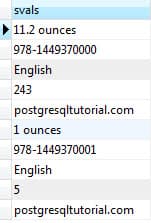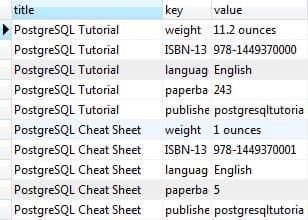Summary: in this tutorial, you’ll learn how to work with PostgreSQL hstore data type.
The hstore module implements the hstore data type for storing key-value pairs in a single value. The keys and values are text strings only.
In practice, you can find the hstore data type useful in some cases, such as semi-structured data or rows with many attributes that are rarely queried.
Enable PostgreSQL hstore extension
Before working with the hstore data type, you need to enable the hstore extension which loads the contrib module to your PostgreSQL instance.
The following statement creates the hstore extension:
CREATE EXTENSION hstore;Create a table with hstore data type
We create a table named books that has three columns:
idis the primary key that identifies the book.titleis the title of the productsattrstores attributes of the book such as ISBN, weight, and paperback. The data type of theattrcolumn is hstore.
We use the CREATE TABLE statement to create the books table as follows:
CREATE TABLE books (
id serial primary key,
title VARCHAR (255),
attr hstore
);Insert data into the PostgreSQL hstore column
The following INSERT statement inserts data into the hstore column:
INSERT INTO books (title, attr)
VALUES
(
'PostgreSQL Tutorial', '"paperback" => "243",
"publisher" => "postgresqltutorial.com",
"language" => "English",
"ISBN-13" => "978-1449370000",
"weight" => "11.2 ounces"'
);The data that we insert into the hstore column is a list of comma-separated key =>value pairs. Both keys and values are quoted using double quotes (“”).
Let’s insert one more row.
INSERT INTO books (title, attr)
VALUES
(
'PostgreSQL Cheat Sheet', '
"paperback" => "5",
"publisher" => "postgresqltutorial.com",
"language" => "English",
"ISBN-13" => "978-1449370001",
"weight" => "1 ounces"'
);Query data from an hstore column
Querying data from an hstore column is similar to querying data from a column with native data type using the SELECT statement as follows:
SELECT attr FROM books;Query value for a specific key
Postgresql hstore provides the -> operator to query the value of a specific key from an hstore column. For example, if we want to know ISBN-13 of all available books in the books table, we can use the -> operator as follows:
SELECT
attr -> 'ISBN-13' AS isbn
FROM
books;
Use value in the WHERE clause
You can use the -> operator in the WHERE clause to filter the rows whose values of the hstore column match the input value. For example, the following query retrieves the title and weight of a book that has ISBN-13 value matches 978-1449370000:
SELECT
title, attr -> 'weight' AS weight
FROM
books
WHERE
attr -> 'ISBN-13' = '978-1449370000';
Add key-value pairs to existing rows
With a hstore column, you can easily add a new key-value pair to existing rows e.g., you can add a free shipping key to the attr column of the books table as follows:
UPDATE books
SET attr = attr || '"freeshipping"=>"yes"' :: hstore;Now, you can check to see if the "freeshipping" => "yes" pair has been added successfully.
SELECT
title,
attr -> 'freeshipping' AS freeshipping
FROM
books;
Update existing key-value pair
You can update the existing key-value pair using the UPDATE statement. The following statement updates the value of the "freeshipping" key to "no".
UPDATE books
SET attr = attr || '"freeshipping"=>"no"' :: hstore;Remove existing key-value pair
PostgreSQL allows you to remove existing key-value pair from an hstore column. For example, the following statement removes the "freeshipping"=>"no" key-value pair in the attr column.
UPDATE books
SET attr = delete(attr, 'freeshipping');Check for a specific key in hstore column
You can check for a specific key in an hstore column using the ? operator in the WHERE clause. For example, the following statement returns all rows with attr contains key publisher.
SELECT
title,
attr->'publisher' as publisher,
attr
FROM
books
WHERE
attr ? 'publisher';
Check for a key-value pair
You can query based on the hstore key-value pair using the @> operator. The following statement retrieves all rows whose attr column contains a key-value pair that matches "weight"=>"11.2 ounces".
SELECT
title
FROM
books
WHERE
attr @> '"weight"=>"11.2 ounces"' :: hstore;
Query rows that contain multiple specified keys
You can query the rows whose hstore column contains multiple keys using ?& operator. For example, you can get books where attr column contains both language and weight keys.
SELECT
title
FROM
books
WHERE
attr ?& ARRAY [ 'language', 'weight' ]; To check if a row whose hstore column contains any key from a list of keys, you use the
To check if a row whose hstore column contains any key from a list of keys, you use the ?| operator instead of the ?& operator.
Get all keys from an hstore column
To get all keys from an hstore column, you use the akeys() function as follows:
SELECT
akeys (attr)
FROM
books; Or you can use the
Or you can use the skey() function if you want PostgreSQL to return the result as a set.
SELECT
skeys (attr)
FROM
books;
Get all values from an hstore column
Like keys, you can get all values from an hstore column using the avals() function in the form of arrays.
SELECT
avals (attr)
FROM
books; Or you can use the
Or you can use the svals() function if you want to get the result as a set.
SELECT
svals (attr)
FROM
books;
Convert hstore data to JSON
PostgreSQL provides the hstore_to_json() function to convert hstore data to JSON. See the following statement:
SELECT
title,
hstore_to_json (attr) json
FROM
books;
Convert hstore data to sets
To convert hstore data to sets, you use the each() function as follows:
SELECT
title,
(EACH(attr) ).*
FROM
books; In this tutorial, we have shown you how to work with the PostgreSQL hstore data type and introduced you to the most useful operations that you can perform against the hstore data type.
In this tutorial, we have shown you how to work with the PostgreSQL hstore data type and introduced you to the most useful operations that you can perform against the hstore data type.
